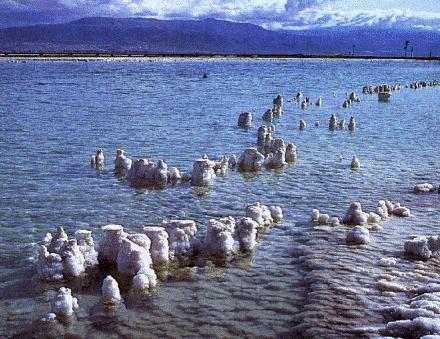NASA has published a study that suggests that a Dead Sea bacterium could teach scientists how to improve protection for astronauts.
Yuval Dror

A few months ago, US President George Bush announced that one of the new missions of the American Space Agency (NASA) is to send astronauts to Mars. One of the biggest obstacles on the way to realizing the vision is the need to protect the astronauts from the intense radiation that prevails in space. At the end of the week, NASA published a study, suggesting that a Dead Sea bacterium could teach scientists how to improve the protection of astronauts.
The journey to Mars should take at least six months each way. During this year, the astronauts will be exposed to large amounts of solar radiation, even before they set foot on the surface of Mars. The radiation is dangerous because it penetrates through the human body and damages the DNA. This damage can cause serious diseases, such as cancer. The question is, is it possible to repair the damaged DNA, and from whom can we learn how to do it. The answer may be hiding in the Dead Sea.
A group of researchers from the University of Maryland found that the bacterium "Halobacterium" has optimally adapted to the harsh life in the Dead Sea. Jocelyn DeRogerio, who heads the group of researchers, explained that the extreme environment in the Dead Sea is due to the salinity of the water, which is ten times greater than in normal seawater (the average salinity of the water in the Dead Sea is about 34%, compared to 3.5% average salinity in the oceans). The DNA molecules inside the cells prefer a watery environment, but the degree of salinity in the Dead Sea water causes water molecules to be removed from the cell, thus damaging the DNA. This is where the special bacteria comes into play.
Halobacterium has a total of 2,400 genes, but it does everything to keep them healthy. For this purpose, he activates a long series of enzymes that function as workers, passing over the DNA molecule and repairing it where it was damaged. The bacterium makes sure that it always has enzymes available for this purpose: if additional enzymes are needed, it produces them quickly. Some of the repair mechanisms found in the bacterium were already known to scientists from plants and animals or other bacteria, but there is a group of enzymes that scientists encountered for the first time in Holobacterium.
"High salinity percentages cause the same damage to the DNA that space radiation causes," Dirogario said. "Therefore, it seems that the organism has developed a mechanism that will allow it to also repair the injuries caused by radiation."
To test this theory, the bacteria were bombarded with intense ultraviolet radiation, the kind that would completely kill other bacteria such as E. coli, which live in the intestines of humans. It did not make a special impression on the halobacterium. 80% of the bacteria remained alive and even multiplied without any problem.
When all the water and air were sucked out of the tank where the bacteria were, they gathered around the salt crystals in the tank and went into a sort of coma. After the salt crystals with the bacteria inside were returned to the water, the bacteria woke up from their coma, repaired the damaged DNA and continued their lives as if nothing had happened.
According to one estimate, bacteria are able to remain in this state for millions of years. If so, the discovery could imply that there are also tiny bacteria in the salt crystals on Mars. "If life evolved on Mars in the form of bacteria, then the water evaporated and the bacteria remained inside the salt crystals, then it is possible that they are still there," said Adrienne Kish, who also participated in the study.
Now the scientists are trying to reveal exactly how the repair mechanisms of the stubborn bacteria work. NASA hopes that understanding the bacteria from the Dead Sea will also help improve the repair mechanisms in the human body. The research has only just begun, but perhaps this will be the mechanism to help the naked astronauts in space.

One response
Boredom